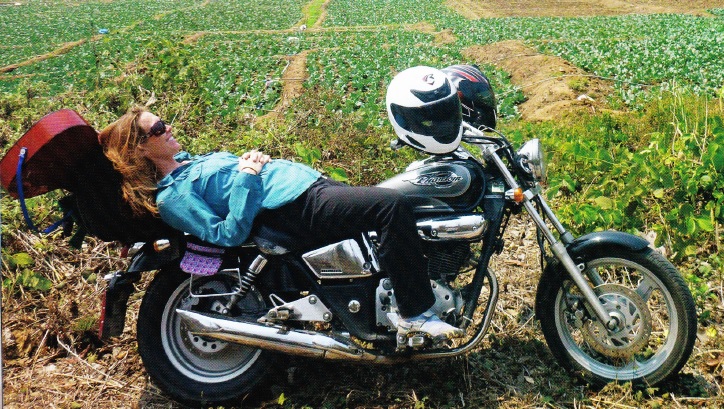As a perfect follow-up to the “typical office day” video I shared earlier this week, here’s the front-page article in the Missoulian newspaper this morning. It’s all about the job we finished, which reconnects two creeks.
It’ll be my last on-the-ground project before we take off to sail and explore for a couple of years. Watch the video for an up-close look at how I rebuilt the stream.
80 years after it was diverted, Twin Creek steered back into Ninemile Creek
By ROB CHANEY of the Missoulian
“That’s pretty awesome,” David Pontrelli yelled as the first muddy cloud from Twin Creek’s new channel bloomed in the clear waters of Ninemile Creek.
On a freezing Friday morning, he saw the result of six weeks of earthmoving and landscape engineering repair a bit of family history.
“My grandpa was a miner up here in the ’30s,” Pontrelli said. “I’m working on some of the same projects he did, putting them back together. We’re making a positive impact, and I’m extremely proud to be a part of that.”
Shortly before World War II, gold miners patented a four-mile stretch of the Ninemile Creek bottom and started dredging the floodplain. Their machines scooped up the creek’s cobbles and gravel into berms 20 feet high, seeking a layer of clay where the valuable minerals hid. Ninemile Creek’s winding oxbows were shunted into a straight-line ditch.
*****
Twin Creek flows into the Ninemile from the hills to the south. When it reached the dredging zone, the miners forced it into a ditch that eventually poured into a pond and percolated away.
“No one’s blaming the miners – they were trying to survive just like the rest of us,” said Trout Unlimited project manager Rob Roberts, who organized the work with cooperation from Missoula County, the Lolo National Forest and the University of Montana. “There’s a lot of debate about how much they found. I think they paid their way. Now we’re trying to create a new legacy for the valley, and return things to the way they were.”
Sort of. To connect the two creeks, Roberts’ crew had to rearrange 16,000 cubic yards of old dredge berm into a causeway across some of the mining channels. That put a pile roughly the size of a football field in a miner’s clearing, with the new creek running 20 feet above the old dredge channel on either side.
Pontrelli and his Streamside Services LLC coworkers hand-placed hundreds of rocks in a series of pools and cascades to mimic the natural contours of a creek. Then they scattered sand, gravel and clay in the bed and blasted the whole mix with water hoses. The goal was to armor the new streambed so water wouldn’t leak out before it reached Ninemile Creek.
*****
Rock and River Co. partners Chance Kirby and Ray Trollope did most of the heavy lifting with their excavator and dump truck. In three weeks, they lifted and moved 1,600 dump-truck loads of fill. On Friday, Kirby got to pull the earthen plug that kept Twin Creek in its ditch. A single bucketful of dirt at 11:31 a.m. was all it took to send the stream tumbling into its new path.
A veteran of the Milltown Dam removal with a dozen years of streambed experience, Kirby used his huge power shovel to re-landscape the area around where Twin Creek used to run. While he transplanted loads of living plants into the old ditch, UM Wildland Restoration students Mark Fogarty and Mark Marano scrambled through the mud seeking stranded fish.
They returned with a 4-inch trout and a handful of minnows for the new channel. Roberts said a stranded population of westslope cutthroat existed in Twin Creek, and now will mingle with the fish in Ninemile Creek. Like first-time homebuyers in a new subdivision, Roberts said fish will flock to the new reach for a while.
Fogarty, Marano and classmate Danielle Berardi also put together a squad of 30 fellow students last weekend to plant thousands of trees and bushes along the new streambed.
Twin Creek was just one of a half-dozen tributaries to the Ninemile diverted for mining. The upper stretch of Ninemile Creek remains trapped in an unnatural channel.
*****
Lolo National Forest soils and water program manager Traci Sylte said Twin Creek didn’t have any serious hazardous waste issues, although other mining-affected creeks higher in the drainage did.
“So far, we’ve done work on Little McCormick, Eustache, Mattie V, St. Louis, Twin, Kennedy and Josephine creeks,” Sylte said. “It’s been great that a lot of private folks have the ethic and desire to give us permission to do this.”
The Twin Creek project cost about $200,000. All combined, the Ninemile drainage streamwork has brought close to $1 million for area excavators, contractors, nurseries and laborers. And there’s been some unpaid labor involved as well.
Over the years, beavers have built ponds that backed up the water and flooded into parallel dredge channels, returning a bit of braiding to the waterway. But lots more work would be needed.
“The only problem is we don’t have enough money to do this for the entire four miles,” Roberts said. “It’s so disturbed in this area, we don’t even know where the floodplain was. It’s completely altered.”




2 thoughts on “Stitching 2 Creeks Back Together Again”
Thanks for all you + TU do at the "office" to clean up and restore. We Ninemilers are forever indebted + appreciative.
Well done!